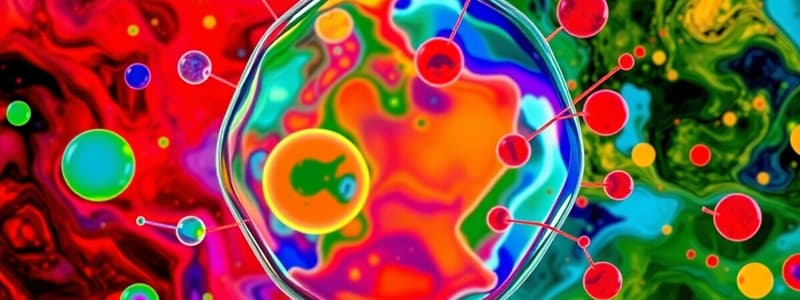Podcast
Questions and Answers
What is the primary site of synthesis for most plasma proteins?
What is the primary site of synthesis for most plasma proteins?
- Pancreas
- Bone marrow
- Spleen
- Liver (correct)
Which of the following statements correctly distinguishes plasma from serum?
Which of the following statements correctly distinguishes plasma from serum?
- Plasma contains fewer proteins than serum.
- Serum has a higher concentration of electrolytes than plasma.
- Serum is obtained with the use of anticoagulants.
- Plasma includes clotting factors, while serum does not. (correct)
In the salting out method for separation of plasma proteins, which plasma protein is classified as the topmost layer when using sodium or ammonium sulfate?
In the salting out method for separation of plasma proteins, which plasma protein is classified as the topmost layer when using sodium or ammonium sulfate?
- Albumin (correct)
- Globulin
- Fibrinogen
- Immunoglobulin
What is the approximate normal concentration of total protein in human plasma?
What is the approximate normal concentration of total protein in human plasma?
What clinical condition might be indicated by a patient exhibiting edema in the feet and significant anemia?
What clinical condition might be indicated by a patient exhibiting edema in the feet and significant anemia?
What might be a consequence of administering sulfonamides to infants?
What might be a consequence of administering sulfonamides to infants?
Which condition is NOT associated with hypoalbuminemia?
Which condition is NOT associated with hypoalbuminemia?
How are α1 and β globulins synthesized?
How are α1 and β globulins synthesized?
What is the significance of α1-antitrypsin in human plasma?
What is the significance of α1-antitrypsin in human plasma?
Which statement about albumin is false?
Which statement about albumin is false?
Which plasma protein is primarily synthesized by plasma cells and B-cells?
Which plasma protein is primarily synthesized by plasma cells and B-cells?
What is a potential effect of decreased albumin synthesis during liver disease?
What is a potential effect of decreased albumin synthesis during liver disease?
In which condition would albuminuria most likely be observed?
In which condition would albuminuria most likely be observed?
Which plasma protein is primarily responsible for maintaining colloidal osmotic pressure?
Which plasma protein is primarily responsible for maintaining colloidal osmotic pressure?
In nephrotic syndrome, which protein is primarily lost in urine?
In nephrotic syndrome, which protein is primarily lost in urine?
What is the function of Prealbumin in the human body?
What is the function of Prealbumin in the human body?
Which condition is characterized by a sharp spike in the electrophoretic pattern due to monoclonal immunoglobulin?
Which condition is characterized by a sharp spike in the electrophoretic pattern due to monoclonal immunoglobulin?
Which of the following statements about albumin synthesis is true?
Which of the following statements about albumin synthesis is true?
Which abnormal condition is associated with an increase in γ globulin levels?
Which abnormal condition is associated with an increase in γ globulin levels?
How does hypoalbuminemia affect fluid distribution in the body?
How does hypoalbuminemia affect fluid distribution in the body?
What is the primary technique used to separate plasma proteins for analysis?
What is the primary technique used to separate plasma proteins for analysis?
Flashcards
What is Plasma?
What is Plasma?
Plasma is the liquid component of blood, containing water, electrolytes, metabolites, nutrients, proteins, and hormones.
What are Plasma Proteins?
What are Plasma Proteins?
Plasma proteins are a diverse group of proteins found in plasma. They are primarily synthesized in the liver and play crucial roles in various bodily functions.
What is Serum?
What is Serum?
Serum is the fluid portion of blood after clotting. It lacks fibrinogen, a clotting factor present in plasma, making it clear.
How are Plasma Proteins Separated?
How are Plasma Proteins Separated?
Signup and view all the flashcards
What are the Major Plasma Protein Groups?
What are the Major Plasma Protein Groups?
Signup and view all the flashcards
Hypoalbuminemia
Hypoalbuminemia
Signup and view all the flashcards
Albuminuria
Albuminuria
Signup and view all the flashcards
Globulins
Globulins
Signup and view all the flashcards
α1-antitrypsin
α1-antitrypsin
Signup and view all the flashcards
Decreased Albumin Synthesis
Decreased Albumin Synthesis
Signup and view all the flashcards
Sulfonamide-Induced Bilirubin Release
Sulfonamide-Induced Bilirubin Release
Signup and view all the flashcards
Kernicterus
Kernicterus
Signup and view all the flashcards
Edema
Edema
Signup and view all the flashcards
Prealbumin (Transthyretin)
Prealbumin (Transthyretin)
Signup and view all the flashcards
Albumin
Albumin
Signup and view all the flashcards
Colloid Osmotic Pressure
Colloid Osmotic Pressure
Signup and view all the flashcards
Plasma Proteins
Plasma Proteins
Signup and view all the flashcards
Prealbumin Deficiency
Prealbumin Deficiency
Signup and view all the flashcards
Multiple Myeloma
Multiple Myeloma
Signup and view all the flashcards
Study Notes
Plasma Composition
- Plasma comprises water (90%), organic compounds (9%), inorganic compounds (1%), and other organic compounds (2%).
- Key plasma proteins include albumin (7%), globulin (2.7%), and fibrinogen (0.3%).
Plasma Proteins
- Plasma contains over 300 different proteins.
- Many illnesses affect plasma protein levels.
- Most proteins are produced in the liver.
- A normal adult's plasma contains roughly 70 g/L of protein.
- Plasma protein concentration in humans is about 6-8.3 g/dL.
- Plasma proteins include simple proteins and conjugated proteins, such as glycoproteins and various lipoproteins.
Learning Objectives
- Students will learn about plasma composition and plasma proteins.
- Students will grasp the difference between plasma and serum.
- Students will understand plasma protein separation techniques.
- Students will familiarize themselves with individual plasma proteins and their functions.
- Students will learn about clinical abnormalities linked to plasma proteins.
Patient Case
- A 50-year-old woman, experiencing unconsciousness, anemia, and edema, had a blood sample taken for lab analysis.
Blood Composition
- Plasma makes up approximately 55% of blood.
- White blood cells and platelets account for less than 1% of blood.
- Red blood cells constitute about 45% of blood.
Functions of plasma Proteins
- Transport: Transferrin carries iron; ceruloplasmin transports copper; albumin transports fatty acids, bilirubin, calcium and many drugs; transcortin transports cortisol and corticosterone; retinol-binding protein transports retinol; haptoglobin transports free hemoglobin; thyroxine-binding globulin transports thyroxine.
- Osmotic Regulation: Plasma proteins maintain blood volume and fluid content in the interstitial fluid.
- Blood clotting: Clotting factors like fibrinogen participate in blood clotting mechanisms. Excess or deficiency may lead to disease states like hemophilia.
- Anticoagulant activity: Plasmin breaks down thrombin and dissolves clots.
- Buffering: Plasma proteins help regulate the body's acid-base balance.
Clinical Significance of Albumin
- Albumin is crucial for maintaining colloidal osmotic pressure.
- Low albumin levels cause fluid retention in tissues (edema).
- Albumin transports fatty acids, preventing them from crossing the blood-brain barrier.
- Bilirubin is bound to albumin; medications can displace albumin's bilirubin binding, causing problems in newborns.
- Albumin synthesis decreases in liver disease or starvation, leading to edema
Synthesis of Albumin
- The liver synthesizes about 12 g of albumin daily.
- This represents 25% of total hepatic protein synthesis.
- Albumin is initially synthesized as a preproprotein.
- A signal peptide and a hexapedide are removed, completing the synthesis pathway.
Other Plasma Proteins: Globulins
- Globulins, separated by half-saturation with ammonium sulfate, have molecular weights ranging from 90,000 to 1,300,000.
- Electrophoresis separates globulins into alpha-1, alpha-2, beta, and gamma globulins.
- Alpha and beta globulins are produced by the liver.
- Gamma globulins are generated in plasma cells and lymphoid tissues.
- Gamma globulin levels rise in infections, liver disease, and various malignancies.
- Specific examples of globulins include alpha-1 antitrypsin, alpha-1 acid glycoprotein, and alpha-1 fetoprotein.
Alpha-1 Antitrypsin
- Also known as alpha-1-antiprotease.
- A single-chain protein with 3 oligosaccharide chains.
- It is the primary component (>90%) of the alpha-1 fraction.
- Produced by hepatocytes and macrophages.
- It's a key inhibitor of serine proteases, like elastase.
- Deficiency leads to proteolytic lung damage (emphysema), often exacerbated by smoking.
a2-Macroglobulin
- Synthesized by hepatocytes and macrophages.
- Acts as a general protease inhibitor, crucial for in vivo anticoagulation.
- Increased levels are frequently seen in nephrotic syndrome.
Ceruloplasmin
- A copper-containing alpha-2-glycoprotein.
- It carries about 90% of the copper in plasma.
- Synthesized by the liver, as apoceruloplasmin, and copper attachment leads to its active form.
Other Properties
- The most clinically important α₂-globulins are haptoglobins, ceruloplasmin, and α₂-macroglobulins.
Other Proteins (β-globulins)
- Key examples in this group are Transferrin, C-reactive protein, hemopexin, complement C1q and B lipoprotein (VLDL).
Critical Clinical Conditions
- Nephrotic syndrome: Low molecular weight proteins (and higher) are lost in the urine, affecting various protein levels in the blood.
- Cirrhosis: Impaired liver function reduces the synthesis of many plasma proteins, including albumin.
- Chronic Infections.
- Leukemias/Lymphoma: Certain types show elevated levels of abnormal plasma proteins.
- Multiple myeloma: Characterized by an abnormal immunoglobulin (light chain) in the urine called Bence Jones protein.
Abnormal Electrophoretic Patterns
- Nephrotic syndrome: Low molecular weight proteins lost in urine.
- Cirrhosis: Decreased albumin, increased globulin.
- Chronic infections, leukemias, and lymphomas: Elevated gamma globulins.
- Rheumatoid arthritis: Elevated gamma and alpha-2 globulin.
- Multiple myeloma: Characteristic spike (M band) due to monoclonal immunoglobulin.
- Alpha-1-antitrypsin deficiency: Thin or missing alpha-1 band.
Prealbumin (Transthyretin)
- A transport protein for thyroid hormones and retinol (vitamin A).
- Migrates faster than albumin in electrophoresis.
- Separated by immunoelectrophoresis.
- Lower levels may indicate liver disease, nephrotic syndrome, acute phase reaction, or malnutrition.
- Short half-life (2 days).
Fibrinogen
- Also called clotting factor 1, and it represents 4-6% of total plasma protein.
- Synthesized by the liver and has 6 polypeptide chains linked by disulfide bonds, essential in blood clotting mechanisms.
- Elevated levels accompany inflammation and some cancers(acute phase proteins).
Negative Acute Phase Proteins
- Albumin, transthyretin (prealbumin), RBP and transferrin can decrease during inflammatory processes.
Cryoglobulins.
- Proteins that precipitate at low temperatures causing obstructions in blood vessels.
General Plasma Protein Function summaries
- Transport: Transport various substances, including hormones, metals, lipids, and drugs.
Studying That Suits You
Use AI to generate personalized quizzes and flashcards to suit your learning preferences.




